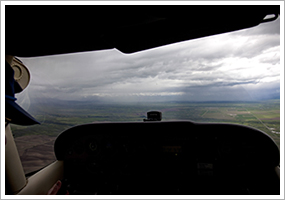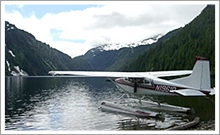The Oct. 1, 2010, issue of 'AOPA ePilot: Flight Training Edition' newsletter
| ||||
| | FT News | INSIDE AOPA | TRAINING PRODUCTS | FINAL EXAM | |||
TRAINING TIPsThe return leg It’s on the return leg of a cross-country, or the later legs of a multi-destination flight, where weather surprises tend to appear. That’s why you should build extra safety margins into planning for flying long distances, or for trips that may require extended time on the ground before returning. You’ll have a good idea of route weather trends if you start checking weather well ahead of your planned departure time. Begin by requesting an outlook briefing whenever your departure time is still more than six hours away. Weather details may still be sketchy, but the big picture is probably emerging. “Such a briefing might help you evaluate your chances of making the flight before planning it out,” explains the article, “The weather briefing,” on the Flight Training website. See the article’s checklist of items to review during a weather briefing. As departure time nears, follow up with a standard briefing. On the ground at your first stop and thereafter, don’t let haste or distractions prevent you from getting more updates. Now it’s time to get abbreviated briefings. How that works is explained in the flight planning article, “Top 10 things a pilot should know about flight service,” on the AOPA website. “The purpose of an abbreviated briefing is to provide you with specific items you have requested to update a standard briefing or mass disseminated information. If you ask for more than two items, specialists are required by the FAA to ask if you want a standard briefing. If you ask for an updated briefing, just let the briefer know what time you had your last standard briefing.” YOUR PARTNER IN TRAININGAs the long days of summer start to wane and the temperatures come down, it’s a good time to review the basics of aircraft icing. Check out the Flight Training archives for stories about airframe icing, carburetor icing, and more. There are even stories about accidents related to carburetor icing, and how to prevent them. The Air Safety Institute also produced a Safety Advisor about icing.
Did you know that student pilots who join AOPA are three times more likely to complete their flight training? Membership includes unlimited access to aviation information by phone (800/USA-AOPA, weekdays from 8:30 a.m. to 6 p.m. Eastern time) or from AOPA Flight Training Online or AOPA Online. If you're not already a member, join today and get the pilot's edge. Login information is available online. FLIGHT TRAINING NEWSTwo university aviation programs could closeAviation degree programs at the University of Illinois at Urbana-Champaign and at St. Cloud State University in St. Cloud, Minn., face the possibility of closure. Robert Easter, interim chancellor at the University of Illinois, outlined plans to discontinue or transfer all academic curricula in the university’s Institute of Aviation in a Sept. 28 letter also signed by Richard Wheeler, interim vice chancellor for academic affairs. “After careful evaluation of the complex, and sometimes competing interest of our students, faculty, and the public, we have concluded that some significant changes should occur,” he wrote. Read more >> California flight training industry unfazed by vetoCalifornia Gov. Arnold Schwarzenegger on Sept. 24 vetoed Assembly Bill 1889, which would have imposed a moratorium on costly new flight training regulations in the state. The governor objected to parts of the bill unrelated to the flight school provision. AOPA was undaunted by the veto: The bill was just one of several legislative vehicles the association has been pursuing to address controversial new flight school regulations from the California Private Postsecondary Act of 2009. AOPA continues to pursue other legislation that could achieve the same end, including the insertion of language into the state budget that would impose the same moratorium. Read more >> Auburn University to study UAS operationsAuburn University received a $300,000 grant to study the operation of unmanned aerial systems (UAS) in the National Airspace System, the university announced. University researchers are trying to determine various classifications of risks associated with certain UAS operations. Ultimately it should help lead the FAA—the agency providing the funding—with additional information necessary to integrate unmanned aircraft into the airspace. Auburn now joins a handful of other universities with aviation programs that are now involved in UAS research or degree programs. TSA interprets ‘recurrent training’ rulesThe Transportation Security Administration issued an interpretation on Sept. 13 excluding 11 “training events” from the definition of recurrent training under the Alien Flight Student Program. The announcement applies to foreign students training in aircraft weighing more than 12,500 pounds. The interpretation, effective Oct. 1, clarifies that training events viewed as checks or tests will not require security threat assessment applications under the program. Read more >> Aviation school shows improving test scoresThe students at Flabob Airport Preparatory Academy on Flabob Airport in Riverside, Calif., are making a name in public education circles. As schools around the country seem to struggle with how to raise standardized test scores, the academy is a test case that shows aviation can have an effect. Students taking standardized Academic Performance Index tests boosted their scores 20 percent year-over-year. According to school officials, that’s more than double the regional average. The academy is open to students in grades seven through 12 and focuses on aviation as a way to motivate students in science, math, engineering, and technology. Read more >> Inside AOPAWhen things go wrong, will you be ready? Although we spend a lot of time training for them, real-world emergencies are rare enough that it’s hardly surprising pilots sometimes get complacent. But emergencies don’t always happen to “other pilots,” and a little preparation can make a big difference when things start to go downhill. Don’t take the head-in-the-sand approach: Get advice on handling those “up here, wishing you were down there” scenarios in the Air Safety Institute’s Emergency Procedures Safety Advisor. Meteorology degree not required Your online weather briefing spews a paper ream of area and terminal forecasts, pressure systems, and frontal boundaries. But how do you become a weather expert to interpret these reports? Hop aboard the Air Safety Institute’s award-winning course WeatherWise: Air Masses and Fronts to lift the ceiling on forces that drive weather systems and how weather may affect your flight. Interactive scenes and visual cues help put official terminology and what to expect outside the cockpit into clear perspective. Complete the course to qualify for AOPA Accident Forgiveness and the FAA Wings program. Don’t fly without legal protection It’s a scary thought, but the reality is every time you fly you’re responsible for complying with at least 700 relevant federal aviation regulations. No matter how good a pilot you are, incidents can happen. Even minor infractions can result in serious penalties. Find out about some of the most common FAA actions and the resulting fines and/or suspensions. Enjoy peace of mind every time you fly knowing that if a federal enforcement action comes your way, you’ll have the best legal advice and support available. Join the thousands of AOPA members who won’t fly without the protection of the AOPA Legal Services Plan. Why use an AOPA credit card? Deciding which credit card to use for various purchases can get confusing. Are you trying to earn points? Support a cause? Redeem rewards? Why not do all three with an AOPA credit card? The WorldPoints rewards program allows you to earn one point for every dollar you spend on purchases, which you can redeem for cash, gift cards, and other rewards. Plus, you will earn two points for every dollar you spend on purchases at select FBOs, for certain AOPA products and services, and at merchants like Sporty's Pilot Shop, Aircraft Spruce & Specialty, Gulf Coast Avionics, King Schools, and Pacific Coast Avionics. More importantly, the AOPA credit card supports general aviation. Read more >> TRAINING PRODUCTSASA 2011 Knowledge Exam products ASA announced recently it has released its line of 2011 knowledge exam products. These include the company’s Test Prep Series, Prepware, and Virtual Prepware. Each features FAA test questions and answers, and other references.
Note: Products listed have not been evaluated by ePilot editors unless otherwise noted. AOPA assumes no responsibility for products or services listed or for claims or actions by manufacturers or vendors. FINAL EXAMQuestion: I just noticed the address on my pilot certificate is my old address. I know I updated my address with the FAA when I moved. Does it matter that my certificate still has the old address?
Answer: Congratulations on meeting the requirement of FAR 61.60, which requires all airmen to notify the FAA within 30 days of a change in their permanent mailing address. This regulation is sometimes overlooked by pilots who don’t realize they can’t exercise the privileges of their certificate until they have informed the FAA in writing of their address change. The fact your certificate still has your old address does not matter as long as the Airmen Certification Branch has your current information. A new certificate will only be issued if you request one. You can do that by filling out form 8060-56: Application for Replacement of Lost, Destroyed, or Paper Airman Certificate or by going to Airmen Online Services and making the request through the FAA’s electronic system. One word of warning, however: The issue date will be updated to reflect the new certificate.
Got a question for our technical services staff? E-mail [email protected] or call the Pilot Information Center, 800/872-2672. Don’t forget the online archive of “Final Exam” questions and answers, searchable by keyword or topic. what’s new onlineWanna be a dead-head? Dead-heading, a description that brings to mind images of expansive Grateful Dead concerts, is actually a term used in the airline industry. Find out what it is on the Flight Training blog with this week’s post. Picture Perfect
AVIATION EVENTS & WEATHER To include an event or to search all events in the calendar, visit AOPA Online. For airport details, including FBO fuel prices, see AOPA Airports. Flight Instructor Refresher ClinicsThe next Air Safety Institute Flight Instructor Refresher Clinics are scheduled in Wichita, Kan., and Nashville, Tenn., Oct. 9 and 10; Indianapolis, Ind., and Corpus Christi, Texas, Oct. 16 and 17; San Jose, Calif., and Fort Lauderdale, Fla., Oct. 23 and 24; San Diego, Calif., Albuquerque, N.M., and Austin, Texas, Nov. 6 and 7. For a complete schedule, see AOPA Online.
Can’t make it in person? Sign up for the CFI Refresher Online. Air Safety Institute Safety SeminarsAir Safety Institute Safety Seminars are scheduled in Bolingbrook, Ill., Oct. 4; Northbrook, Ill., Oct. 5; Rockford, Ill., Oct. 6; Poughkeepsie, N.Y., and Madison, Wis., Oct. 11; Colorado Springs, Colo., Cohoes, N.Y., and Milwaukee, Wis., Oct. 12; Northglenn, Colo., Tompkinsville, Ky., Gaithersburg, Md., and Manitowoc, Wis., Oct. 13; Mount Sterling, Ky., Oct. 14; Ypsilanti, Mich., and Portland, Ore., Oct. 18; Cleveland, Ohio, and Seattle, Wash., Oct. 19; Columbus, Ohio, Oct. 20; Indianapolis, Ind., Oct. 21. Topics vary—for details and a complete schedule, see AOPA Online. | Got news? Contact ePilot. Having difficulty using this service? Visit the ePilot Frequently Asked Questions now at AOPA Online or write to [email protected]. |
| Editorial Team: ePilot Flight Training Editor : Jill W. Tallman | ePilot Editor: Sarah Brown | Contributor: Alton K. Marsh |

 The further into the future a pilot needs to forecast weather, the less likely weather is to cooperate. You’ll encounter that fact of aviation life when cross-country training begins.
The further into the future a pilot needs to forecast weather, the less likely weather is to cooperate. You’ll encounter that fact of aviation life when cross-country training begins.


